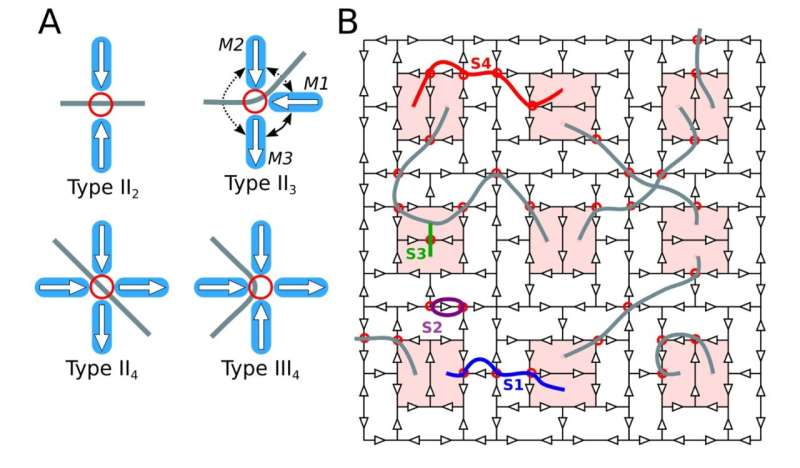Magnetic energy strings flex, wiggle and reconnect in a nanomagnetic array

A multi-institutional team exploring the physics of collective behavior has developed and measured a model nanomagnetic array in which the behavior can be best understood as that of a set of wiggling strings. The strings, which are composed of connected points of high energy among the lattice, can stretch and shrink, but also reconnect. What makes these strings special is that they are limited to certain endpoints and must connect to those endpoints in particular ways.
These constraints on the strings’ behavior are an example of what physicists call topological behavior, which is related to a wide range of topics from the shape of a donut to how electrons travel through certain cutting-edge semiconductors.
“Topological physics has raised much recent interest, mostly in the quantum domain,” said Cristiano Nisoli, a Los Alamos National Laboratory researcher and co-author of the work published in Science. “We had already demonstrated a few times, theoretically and experimentally, that features once believed to be inherently quantum can be reproduced by systems of classical interacting nanomagnets.”
According to co-author Peter Schiffer, a Yale applied physics professor, “This system is an instance in which topologically driven features appear in a purely classical material system—that makes them easier to study and characterize.”
Santa Fe spin ice inspired by New Mexico brick floor
The work is in the context of an ongoing collaboration between Nisoli’s group in the Los Alamos Theoretical division and the experimental work of Schiffer and his team at Yale University. Starting in 2006, together with others, the two had introduced the idea of bottom-up fabrication of “artificial spin ice” structures made of interacting magnetic nano-islands. The team for this study also included Yale researchers Xiaoyu Zhang, Grant Fitez, Shayaan Subzwari, Ioan-Augustin Chioar, Hilal Saglam and Nicholas Bingham (now at the University of Maine), as well as Justin Ramberger and Chris Leighton at the University of Minnesota.
“Initially, we concentrated on simple geometries and models, sometimes mimicking existing natural materials,” Nisoli said. “But since the beginning, the idea was more ambitious: instead of finding serendipitously exotic or useful phenomena in natural materials, we sought to produce artificial ones where new phenomena could be designed in, and checked in highly controllable ways, perhaps in view of future functionalities, such as memory storage or computation.”
The teams developed—first theoretically at Los Alamos, and then experimentally at Yale and the Advanced Light Source facility at Berkeley National Laboratory—a geometry called Santa Fe spin ice, inspired by the shapes in a brick floor in Santa Fe, New Mexico. “The interesting fact about Santa Fe spin ice is that although it is made of a bunch of binary magnets, it can also be completely described as a set of continuous strings,” Nisoli noted.
In a previous work, the authors fabricated the Santa Fe spin ice and demonstrated the existence of these strings and their properties. In the present work, they studied how the strings move. Using the photoemission electron microscopy characterization done at Berkeley was especially valuable in that “it effectively provides video clips of the nanomagnets in space and in time, so we could watch them as they spontaneously switched their north and south poles,” said Schiffer of Yale. “The nano-islands are fabricated to be very thin, just a few nanometers, so that they flip their poles just from being at finite temperature, in a well-known phenomenon called superparamagnetism.”
At high temperatures, the researchers observed the merging and reconnecting of strings, resulting in the system transitioning between topologically distinct configurations. But below a crossover temperature, the string motion was limited to simple changes in length and shape. Therefore, the work shows that there is a dynamic crossover: below a certain temperature those topologically non-trivial moves become suppressed, and only the topologically trivial (wiggling, extending and contracting) remain.
Kinetic crossover breaks rules
“Here, we have shown a real system, artificially fabricated, that experimentally demonstrates a kinetic crossover that breaks the rule of randomness, or ergodicity, because below a certain temperature it suppresses the kinetic pathways that are topologically non-trivial, and remains confined into a topological class,” Nisoli said. “With the measurements we could perform, we were able to literally watch these nanoscale strings go through their motions and make an unexpected transition in behavior.”
“This level of insight is unusual for any system, and it sets the stage for other topological studies in the future,” said Schiffer.
More information:
Xiaoyu Zhang et al, Topological kinetic crossover in a nanomagnet array, Science (2023). DOI: 10.1126/science.add6575
Citation:
Magnetic energy strings flex, wiggle and reconnect in a nanomagnetic array (2023, May 4)
retrieved 4 May 2023
from https://phys.org/news/2023-05-magnetic-energy-flex-wiggle-reconnect.html
This document is subject to copyright. Apart from any fair dealing for the purpose of private study or research, no
part may be reproduced without the written permission. The content is provided for information purposes only.
For all the latest Science News Click Here
For the latest news and updates, follow us on Google News.

